Specifications:
Displacement 2,450 t.
Length 257'
Beam 45'
Draft 20' 6"
Speed 8kts
Complement unknown
Armament
Propulsion steam
| Click On Image For Full Size Image |
Size | Image Description | Contributed By |
|
|---|---|---|---|---|
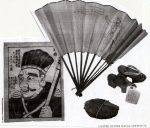 |
159k | The tobacco plug shown below was among the Japanese Emperors gifts to Commodore Perry. The "Lew Chew" was present along with a silk tobacco pouch
and pipes. While some of the tobacco specimens were transferred to the Department of Agriculture, this one was labeled as "Specimen of Native Tobacco" and brought into
the collection of the National Museum. As for the shoes, a handwritten note makes the not-impossible claim that they were the first purchase make by Americans in Japan. First purchase of a Japanese product. They were women's footwear made from paulownia wood, plaited rush, white leather and white tacks. The shoes may have been the first purchase, but the minogami (mulberry bark paper) fan marks the start of another trend-the Japanese fan as an American souvenir. Mounted on ten bamboo ribs and edged with gold in the upper margins, it bears the inscription of Perry's paymaster, Thomas C. Dudley which reads "My portrait twice as natural, done by a Japanese at Yokohama Jeddo (Edo) Bay, March 31, 1854. Undoubtedly this was a personnel gift to Dudley on the occasion of a first meeting. Finally, what more evocative example of Japanese art could an expedition acquire than a wood block print? This one bears a particularly exotic and fearsome countenance. Some martial deity, perhaps? In fact it is none other than Commodore Perry himself. Image courtesy United States Naval Institute. |
Tommy Trampp | |
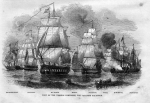 |
294k | US Navy ships of the Japanese Squadron, established to promote free trade with Japan in 1852. From left to right:
USS Susquehanna, USS Saratoga, USS St. Mary's, USS Supply, USS Plymouth, USS Perry, USS Mississippi and USS Princeton. From ~ The Archive of the Old Print Man ~ "Gleason's Pictorial Drawing Room Companion", Boston, 1852. |
Tommy Trampp | |
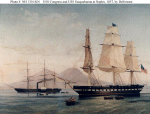 |
78k | Oil painting by Desimone of USS Congress (right) and USS Susquehanna (left distance) at Naples in 1857. Courtesy of the U.S. Navy Art Collection, Washington, D.C. US Naval History and Heritage Command Photo # NH 1310-KN (Color). |
US Naval History and Heritage Command | |

098603808 |
163k | "Napha From the Sea" (Japan). Lithograph by J. Queen, after W. Heine and H. Walke, published by P.C. Duval and Company, circa the later
1850s. It shows ships of Commodore M.C. Perry's Squadron at Naha, Okinawa, circa 1853-1854. Steamers are (center)
USS Mississippi and (right) either USS Powhatan or USS Susquehanna, circa later 1850s. Courtesy of and copied from the Collection of President Franklin D. Roosevelt, April 1936. This print was exhibited at the Corcoran Gallery in April 1963. Catalog #131. US Naval History and Heritage Command photo # NH 42760. |
Robert Hurst | |

098611210 |
278k | A Japanese print relating to Commodore Perry's visit. 1 January 1854. The paddlewheel steamer depicted would be either
USS Mississippi (Commodore Perry's flagship), or USS Susquehanna - the only two paddlewheels on Perry's first visit to Japan.
English Wikipedia |
Robert Hurst | |
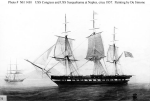 |
61k | Oil painting by Desimone of USS Congress (right) and USS Susquehanna (left distance) at Naples about 1857. Collection of President Franklin D. Roosevelt, 1936. US Naval History and Heritage Command Photo # NH 1230. |
US Naval History and Heritage Command | |
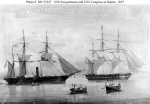 |
76k | Oil painting probably by Desimone of USS Congress (right) and USS Susquehanna (left) at Naples about 1857. Note local rowing craft in the foreground. US Naval History and Heritage Command Photo # NH 55327. Courtesy of Mr. K. Scofield, July 1939. |
US Naval History and Heritage Command | |
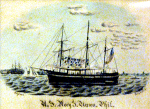
098603805 |
214k | A woodcut engraving of the Steam Frigate USS Susquehanna, 1858.
From Harper's Magazine, N.Y. Independence Seaport Museum. Photo taken 26 February 2011 by ©Piotrus (real name unknown). |
Robert Hurst | |
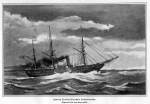 |
438k | A contemporary rendering of the sidewheel frigate USS Susquehanna in heavy seas. | US Navy History and Heritage Command | |
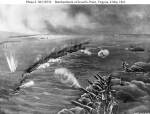 |
130k | Bombardment of Sewell's Point, Virginia, 8 May 1862. Print published in Fiveash, "Virginia-Monitor Engagement", Norfolk, Virginia, 1907. It depicts USS Monitor (at left) accompanied by the Federal war ships USS Naugatuck, USS Dacotah, USS Seminole and USS Susquehanna (listed in no particular order, and depicted rather inaccurately), firing on the Confederate batteries at Sewell's point, near Norfolk VA. US Naval History and Heritage Command Photo # NH 58756. |
Robert Hurst | |
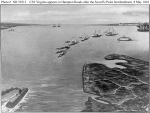 |
118k | Published in Fiveash, "Virginia-Monitor Engagement, Norfolk, Virginia, 1907". It depicts
CSS Virginia (at left) making her appearance near Craney Island as
USS Monitor (left center) and other Federal warships withdraw after bombarding Sewell's
Point, near Norfolk. The other U.S. Navy ships presented included
USS Naugatuck,
USS Dacotah,
USS Seminole and
USS Susquehanna.
US Naval History and Heritage Command Photo # NH 59213. |
Robert Hurst | |
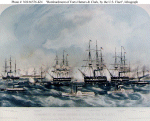 |
93k | "Bombardment of Forts Hatteras & Clark, by the U.S. Fleet"
"Under the command of Flag Officer Silas H. Stringham, on the 28th and 29th of August 1861" A colored lithograph by J.P. Newell after a drawing by Francis Garland,
Seaman in USF Cumberland, published by J.H. Buford, Boston, Massachusetts, 1862.
Features identified below the image are (from left to right):
USS Susquehanna; tug Fanny; Fort Hatteras; USS Harriet Lane; Fort Clark; USS Cumberland; steamer Adelaide; USS Minnesota; steamer George Peabody; USS Wabash; USS Pawnee; and USS Monticello. Courtesy of the U.S. Navy Art Collection, Washington, D.C. US Naval History and Heritage Command Photo # 66576-KN (Color) |
US Naval History and Heritage Command | |
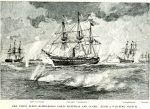 |
522k | USS Minnesota (center), USS Susquehanna, USS Pawnee and other Union warships bombard Confederate forts during the Battle of Hatteras Inlet Batteries. Image from the book 'Battles and Leaders of the Civil War, p.667, being for the most part contributions by Union and Confederate officers, based upon the Century War Series, volume 1, by Robert Underwood Johnson and Clarence Clough Buel. Image courtesy of the British Library from its Digital Collection. |
Robert Hurst | |
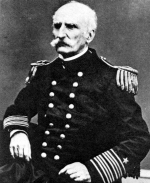 |
201k | USS Susquehanna with CAPT. James L. Lardner in command, participated in Flag Officer Du Pont's expedition to South Carolina, capturing Port Royal Sound and Beaufort in late fall of 1861. From various official reports it appears that during the three hours and forty five minutes the engagement lasted the Susquehanna fired from her fifteen guns four hundred and seventy-four 8-inch shell, about twenty solid 8-inch (64 pounds), and some grape and canister rounds for anti-personnel suppression. | Bill Gonyo | |
 |
75k | "Bombardment and Capture of Port Royal, South Carolina, 7 November 1861"
Engraving published in "Harper's Weekly", July-December 1861 volume, pages 760-761.
It depicts Federal warships, under Flag Officer Samuel F. DuPont, USN, bombarding Fort Beauregard (at right) and Fort Walker (at left). The Confederate squadron commanded by Commodore Josiah Tattnall is in the left center distance.
Subjects identified below the image bottom are (from left):
tug Mercury, Fort Walker, USS Wabash (DuPont's flagship), steamer Screamer (?), USS Susquehanna, CSS Huntsville, Commo. Tattnall, (probably misidentified as no record exists that CSS Huntsville served in the defenses of Port Royal, S.C. USS Bienville, USS Pembina, USS Seneca, USS Ottawa, USS Unadilla, USS Pawnee, USS Mohican, USS Isaac Smith, USS Curlew; (probably misidentified as no record exists that USS Curlew served with South Atlantic Blockading Squadron), USS Vandalia, USS Penguin, USS Pocahontas, USS Seminole, Fort Beauregard, USS R.B. Forbes and "Rebel Camp". US Navy photo # NH 59256 |
US Naval History and Heritage Command | |
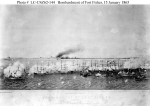 |
94k | "Bombardment of Fort Fisher"
"Jan. 15th 1865" Lithograph after a drawing by T.F. Laycock, published by Endicott & Co., New York, 1865, depicting the North Atlantic Blockading Squadron bombarding Fort Fisher, North Carolina, in preparation for its capture. The print is dedicated to Commodore S.W. Godon, USN. Ships present, as named on the original print, are (from left to right in the main battle line): USS Tacony; USS Maumee; USS Ticonderoga; USS Shenandoah; USS Tuscarora; USS Juniata; USS Wabash; USS Susquehanna; USS Colorado; USS Minnesotaa; USS Brooklyn; USS New Ironsides and USS Mohican. Ships in the foreground are (left to right, from the center of the view): USS Powhatan; USS Mackinaw; USS Vanderbilt and USS Malvern (Flagship of Rear Admiral David Dixon Porter). Monitors in the right middle distance are: USS Monadnock (with two turrets); USS Mahopac; USS Saugus and USS Canonicus. US Naval History and Heritage Command photo # LC-USZ62-144 from the collections of the Library of Congress. |
Bill Gonyo | |
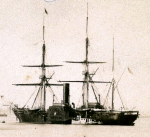 |
311k | USS Susquehanna at anchor, circa 1860's, by Frederick Gutenkunst. | Robert Hurst | |
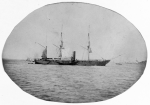
098603807 |
156k | USS Susquehanna during or after the Civil War, circa 1861-1865, location unknown.
US Naval History and Heritage Command photo # NH 48101. |
Robert Hurst | |
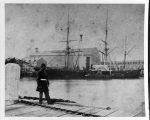
098603806 |
236k | USS Susquehanna at the New York Navy Yard, circa 1866-1868. Note Marine officer in foreground, and small barge alongside
Susquehanna.
US Naval History and Heritage Command photo # NH 86967. Courtesy of Martin Holbrook, 1977. |
Robert Hurst | |
USS Susquehanna (I)
Dictionary of American Naval Fighting Ships (DANFS)
| Back To The Navsource Photo Archives Main Page | Back To The Old Navy" Steam and Sail Index |
| Comments, Suggestions, E-mail Webmaster. |
|
This page is created and maintained by Gary P. Priolo |